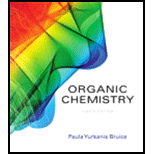
(a)
Interpretation:
To explain the reason for not obtaining the ester by dissolving by dissolving
Concept introduction:
Esterificationis the process in which carboxylic acid reacts with alcohol in the presence of an acid to produce an ester. Carboxylic acid undergoes nucleophilicsubstitution reaction. The acid protonates the oxygen of carboxylic acid which results in increased electrophilicity of the carbonyl carbon. The alcohol acts as a nucleophile and gets attached to the carbonyl carbon of the carboxylic acid. Proton transfer takes place between alkoxy group and a hydroxy group. Water molecule gets eliminated from the tetrahedral intermediate. The proton releases from the carbonyl oxygen to form ester.
(b)
Interpretation:
To explain the reason methyl ester can form by dissolving
Concept introduction:
Esterificationis the process in which carboxylic acid reacts with alcohol in the presence of an acid to produce an ester. Carboxylic acid undergoes nucleophilicsubstitution reaction. The acid protonates the oxygen of carboxylic acid which results in increased electrophilicity of the carbonyl carbon. The alcohol acts as a nucleophile and gets attached to the carbonyl carbon of the carboxylic acid. Proton transfer takes place between alkoxy group and a hydroxy group. Water molecule gets eliminated from the tetrahedral intermediate. The proton releases from the carbonyl oxygen to form ester.
Want to see the full answer?
Check out a sample textbook solution
Chapter 15 Solutions
Organic Chemistry; Organic Chemistry Study Guide A Format: Kit/package/shrinkwrap
- Would it be favorable to get a 1,4-adduct of anthracene and maleic anhydride? Why or why not? If the 1,4-adduct of anthracene and maleic anhydride had formed, would it have different exo and endo isomers?arrow_forwardExplain why the circled compound (that is not crossed off) will form an anhydride upon heating.arrow_forwarda) Put these three common types of carbonyl compound in order of decreasing reactivity ester amide acid chloride b) For the least reactive, show the interconversion to its other resonance form: How does this electron delocalisation make it stable? c) For the most reactive, draw the mechanism of its undergoing hydrolysis (reaction with H2O): Why makes this type of carbonyl so reactive to nucleophiles?arrow_forward
- Why is a protecting group used in this reaction? Ethylene glycol can be recycled which would decrease the E-Factor of this reaction. explain why this is based on the reaction scheme above.arrow_forwardIf there was some carboxylic acid remaining at the end of the reaction, what are two possible ways you could remove it to isolate your pure ester?arrow_forwardIs the crude (non-crystallized) acetanilide pure? Why or why not? Is the crystallized acetanilide pure? Why or why not?arrow_forward
- Why is an alkylamine more basic than ammononia?arrow_forwarda. What is the purpose of adding Sodium carbonate to the black tea? You can explain its purpose as a paragraph or by showing the reaction of one phenolic compound reacting with it.b. Do you expect this phenolic compound to be soluble in water or DCM?arrow_forwardShow the arrow pushing mechanism for getting tropylium ion from the benzylic carbocationarrow_forward
- Draw the major organic product for the reaction in Part 1 and for the reaction in Part 2.arrow_forward- The reaction that will be carried out in the lab will convert 9-fluorenol to 9-methoxy fluorene usinga nucleophilic substitution reaction. Question: Why is concentrated sulfuric acid used in this reaction and not aqueous acid? Draw the reaction and show the equilibrium that is dependent on the acid.arrow_forwardWhy do we add sodium hydroxide to the extracted organic solvent in caffeine extraction procedure? A. to get rid of basic impurities B. to get rid of acidic impurities. C. to get rid of polar impurites. D. to get rid of phenolic impurities.arrow_forward
 Organic Chemistry: A Guided InquiryChemistryISBN:9780618974122Author:Andrei StraumanisPublisher:Cengage Learning
Organic Chemistry: A Guided InquiryChemistryISBN:9780618974122Author:Andrei StraumanisPublisher:Cengage Learning
